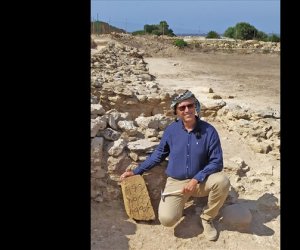Phoenician tombs and an inscribed stela were discovered last month in Motya, western Sicily, during an excavation by the Sapienza University of Rome Expedition. The archaeologists uncovered 400 tombs in total. Out of the graves, 10 percent were accompanied by stelae or inscriptions. One inscription indicated that its grave was likely the resting place of an important priest or perhaps the ruler of Motya.
“This is among the few monumental inscriptions found in the island of Motya inscribed on a tombstone,” lead archeologist Lorenzo Nigro told The Daily Star by email. “According to the most recent demographic model made by Sapienza University of Rome Expedition, about 120,000 people lived in the Phoenician port city.
“Only a very small part of the community deserved a burial (incineration or inhumation),” he added. “We thus understand that the owner of the tomb, Abed-Melqart, was a member of the ruling elite, an aristocrat, a priest or even a king. His name mentions the main god of the city of Motya, to whom was dedicated a monumental temple, which our expedition is excavating some 100 meters far from the place where the inscription was found.”
Nigro is also part of Lebanon’s Phoenician Heritage Institute, founded in 2018, which seeks to collect, archive and preserve written and visual documents and records on Phoenician civilization, making these resources available to scholars and the public.
Only the upper part of the sandstone stela, painted red at the top and dating from the end of the seventh century B.C., was found. Nigro believes the lower part could still be unearthed following further excavation, as the stela was found in the last hour of the final day of the dig.
“The inscription is preserved on four lines of very well-carved letters painted on one side,” Nigro said. “All together the inscription thus reads, ‘Tomb of Abed-Melqart son of.’”
“Melqart, one of the main gods of the Phoenicians, was worshipped in Tyre as the deity connected with kingship,” he added. “The inscription testifies [to] the power of the Phoenician culture and alphabet in its spread over the Mediterranean.”
The stela was found underneath a tower of Motya’s earliest city wall, which Sapienza University has been excavating over the last two years. The rich history of the island has justified 39 excavation seasons since 1964.
In the 17th century B.C., Levantine and Cypriot navigators reached Motya, and it later acquired a central role in trade and other exchanges between East and West. Around 800 B.C., a small group of migrants from Phoenicia settled on the island and founded a temple devoted to the god Baal and another to the goddess Astarte in a nearby spring, making Motya among the earliest Phoenician settlements in the central Mediterranean.
“After two centuries, Motya, with its 5,000 inhabitants, was a major city of the Mediterranean with two main sacred areas, numerous temples, palaces, buildings and two harbors,” Nigro said. “Motya was an independent free port city, which attracted groups of merchants, sailors and also people leaving the homeland where war and taxes were stressing the populations.
“Its increasing wealth disturbed the other major city in the central Mediterranean, [another Phoenician-founded center] Carthage. During the sixth century B.C., the city was conquered by the Carthaginian Gen. Malco and submitted to the military control of Carthage,” he added. “During this century, Motya was thus fortified by erecting a monumental city-wall” around the 40-hectare city.
The island has become a tourist attraction that is said to be visited by some 150,000 people a year.
Nigro’s team works each year on excavation and restoration, uncovering the monuments of the ancient Phoenician city.
The next step for the team will be consolidation, research and more exploratory digs in the area.

 Sezioni
Sezioni



















 Il caso Iuventa/ 5. La fine di un'inchiesta costata 3 milioni di euro " >
Il caso Iuventa/ 5. La fine di un'inchiesta costata 3 milioni di euro " >







